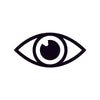UV Light & Your Eyes
Designer sunglasses are must-have fashion accessories in the summertime, but they also serve the more important function of preventing the direct impact of UV light in your eyes and reducing the risk of eye damage. Like how sunscreen keeps our skin safe from the sun’s harmful rays and helps prevent skin cancer and premature ageing, sunglasses keep us safe by minimising the risk of UV light in the eyes.
Long exposure to the sun’s UV light has effects on the eyes, potentially causing structural eye damage (1) and, in some cases, vision impairment. Children are at a high risk of exposure to the sun’s UV light, especially in areas prone to increased sun reflection, such as beaches or snowy areas. This makes it crucial for you to understand the UV light’s effects on the eyes to protect your and your child’s vision in the long run. Without adequate protection, potential damage to the eye can include corneal inflammation, cataracts, pterygium, and cancer.
UV light and its effects
Ultraviolet light and radiation come from two sources. The primary source of earth’s UV light — the sun — emits a range of wavelengths known as the electromagnetic spectrum. UV lights appear in the middle of the spectrum between visible light and X-rays and are split into three main types, including UVA, UVB and UVC.
While most of the sun’s UV radiation is absorbed by the ozone layer, a scientific study has highlighted the need for wearing sunglasses due to atmospheric changes and the depletion of the ozone, leading to an increased level of UV radiation on the earth (3).
The main secondary sources of UV radiation are tanning lamps, high-intensity mercury vapour lights, halogen lights, welding arcs, and lasers. Since this initial study was carried out, we have also broadened our understanding of the irreversible effects of UV light on the eyes and have globally recognised the need for UV-protected sunglasses, whether outdoors or handling sensitive equipment.


